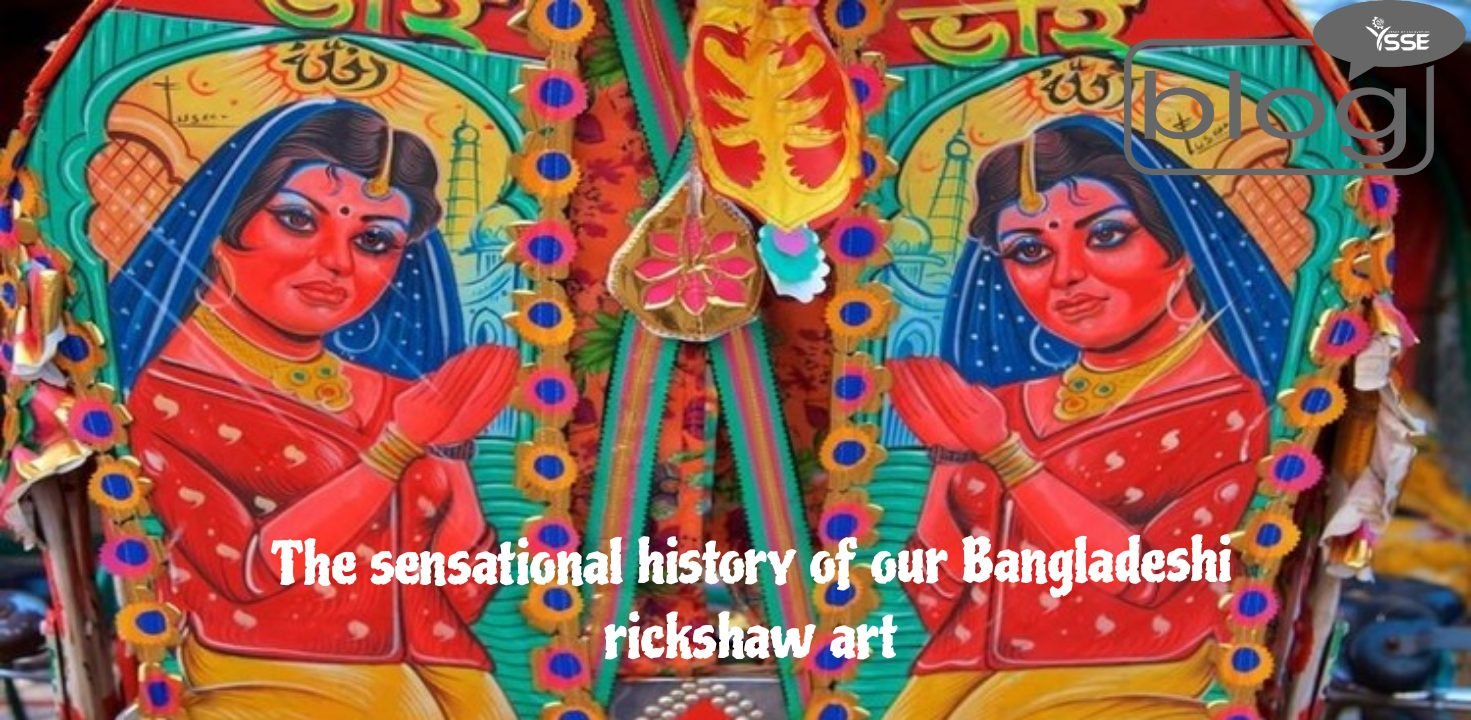The rickshaw, created in Japan in the late 19th century, is a three-wheeled human-powered transportation, used for carrying people and goods. In Bangladesh, it is known as “Ricksha.” Rickshaws serve as a moving art exhibition with colorful and captivating paintings depicting themes of everyday life, culture, and imagination. The art on rickshaws includes geometric designs, flowers, birds, actresses, and expressions of the driver’s religious beliefs or social commentary. Despite being looked down upon by the elite, rickshaw art gained popularity in Bangladesh from the 1950s onwards.
Introduced in Dhaka in 1938 with only six rickshaws, the number grew over time, earning Dhaka the title of the “city of rickshaws.” Initially met with skepticism, the rickshaw became a popular mode of transport in both urban and rural areas. The art on rickshaws evolved with movie banners becoming a source of inspiration, and the migration of villagers to Dhaka for employment further contributed to its popularity. The art themes expanded to include village scenes, futuristic cities, animals, monuments, fairy tales, and religious symbols. The Taj Mahal holds a special place as a beloved monument frequently featured in rickshaw art.
As Dhaka sprawled as the capital of the province of East Pakistan, people from the villages were drawn to it for employment. Many of them ended up as rickshaw pullers, having failed to secure any better job. These migrants from villages must have found pulling a rickshaw painted with rural scenes emotionally satisfying and surely instantly identified themselves with the scenes.
There is a lot of repetition, either because of the popularity of some motifs or because of the influence of the master craftsman. The paintings are executed quickly, with readymade enamel paints, which do not allow paints to be mixed. Bright primary colors are popular and the painting is flat, lacking shadows, perspective, and scale.
Despite facing challenges, especially in the 1950s, Bangladesh’s rickshaw art gained global fame, spreading Bangladeshi art and culture worldwide. This recognition increased in the 1990s, drawing contemporary artists and the public’s attention to the unique and expressive form of rickshaw art.
Early 20th Century (1900-1950): British colonial authorities prescribed rickshaw colors to avoid excessive flamboyance in public spaces.
1950s (1950-1960): Movie star portraits began gracing rickshaws, initially in simpler forms.
1960s (1960-1970): The time between the ’60s and ’70s is known as the golden period of the rickshaw art of Bangladesh. This was the period when rickshaw art began to diversify and accommodate even more popular tests. During this period, movie scenes and actors were added to rickshaw art as these were too popular subjects for the people. This art was inspired by contemporary Indian and Pakistani movies and actors such as Dilip Kumar, Nargis, Raj Kapoor, Madhu Bala, Boijanti Bala, Uttam Kumar, Suchitra Sen, etc. Besides, the depiction of “thinly veiled women” in rickshaw paintings was banned at this time.
Early 1970s (1970-1975): Immediately after independence, the artists focused on images of the Bangladesh Liberation War. Atrocities of the Pakistan army, battle scenes between the Pakistan army and freedom fighters of Bangladesh, portraits of Bangabandhu Sheikh Mujibur Rahman, and other patriotic and heroic images of the war embellished rickshaws. Some Liberation war scenes appeared in rickshaw paintings for a short time during that year, such as torture, killing, enemies, and freedom fighters, scenes of tanks being destroyed, and fighter planes sweeping across the sky. The Pakistani army’s atrocities against women were a very common subject of that period. One image in particular of a fierce-looking Pakistani soldier pulling a woman’s sari was very popular.
1982: Human images, including scenes from movies, reappeared in rickshaw art. Artists did not stop creating animal images even though the political situation changed. By this time, some rickshaw makers had already begun installing transistor radios just above the footboard; rickshaws so equipped became known as ‘disco rickshaws’.
Early 1990s (1990-1995): Global awareness influenced rickshaw art, featuring images of the Gulf War and Saddam Hussein.
Early 2000s (2000-2005): Post 9/11, rickshaw paintings depicted Osama bin Laden and Saddam Hussein together.
2010-Present: Digital printing impacted art, leading some artists to switch professions.
In Bangladesh, vibrant pop art on rickshaws, crafted by mostly illiterate artists, is passed down through generations without copyright or individual attribution. Though marked by a steel pin, the art struggles for survival as newer generations show declining interest due to low incomes and lack of recognition. In 2023, UNESCO acknowledged Dhaka’s rickshaw art as an Intangible Cultural Heritage, a crucial milestone for the global visibility and preservation of this tradition.
To read more blogs like this, click here.
Tasrin Jerin Mim
Intern,
Content Writing Department,
Youth School for Social Entrepreneurs (YSSE)

